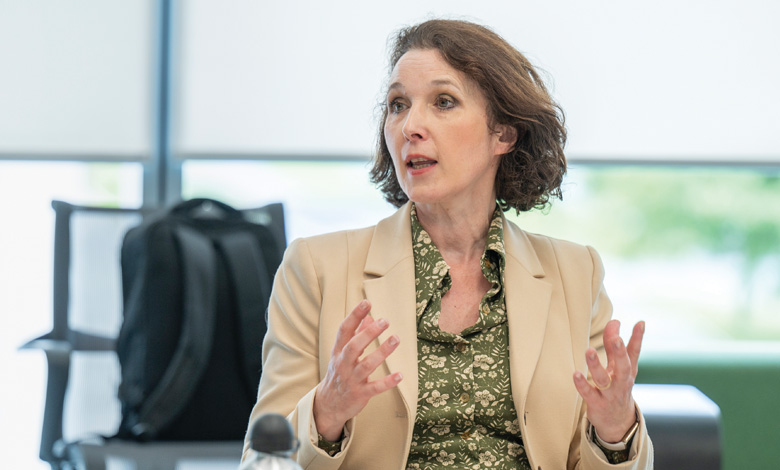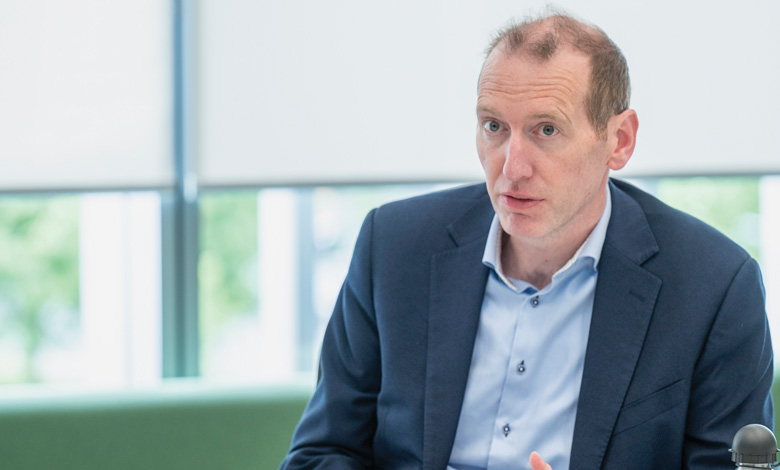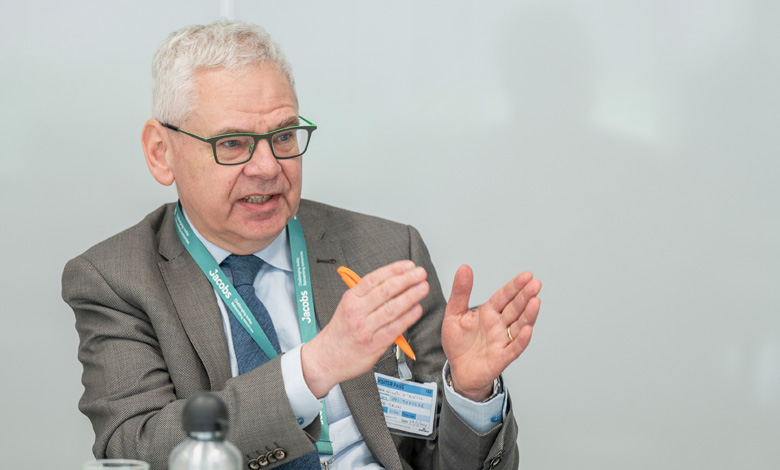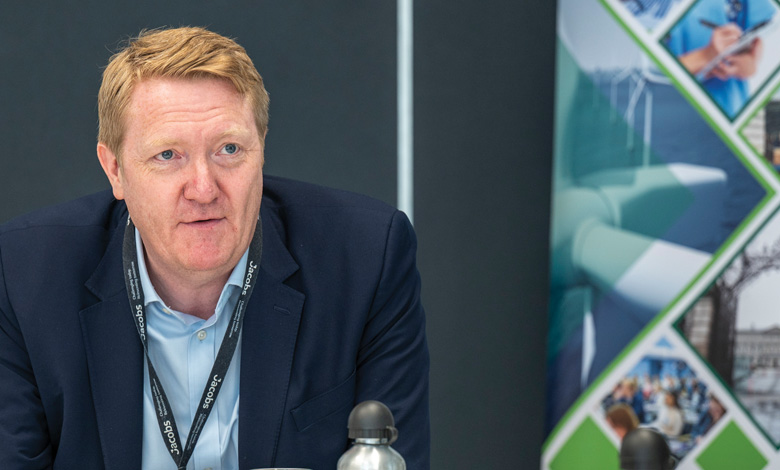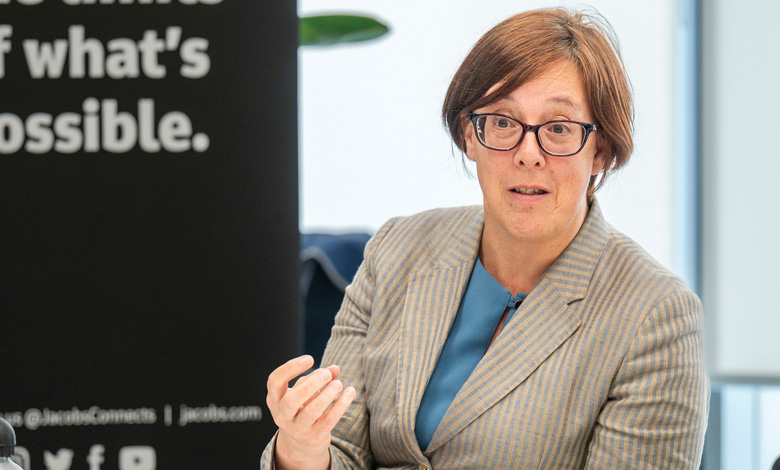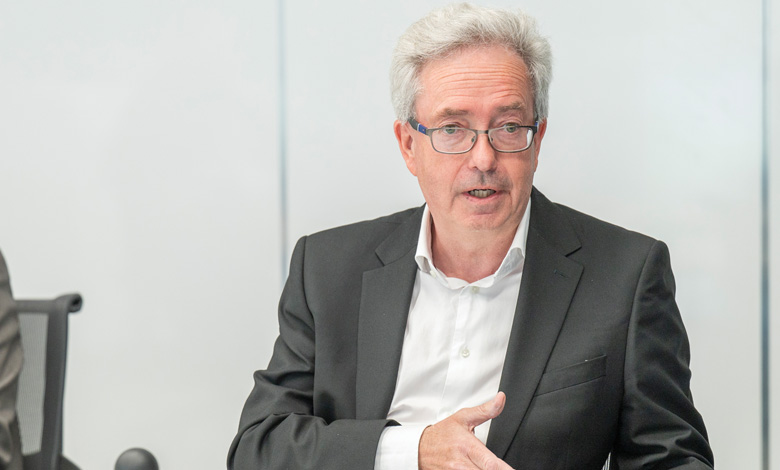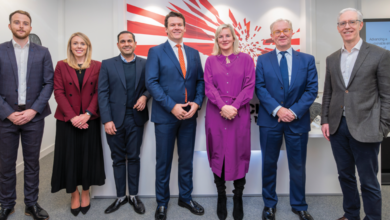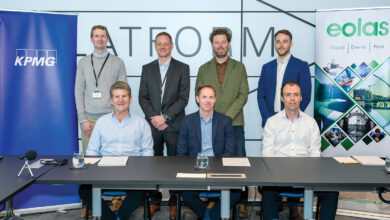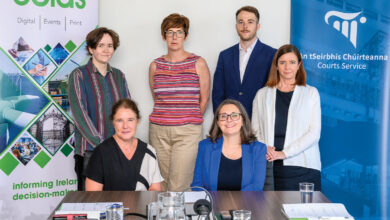A macro view of Ireland’s decade of infrastructure delivery
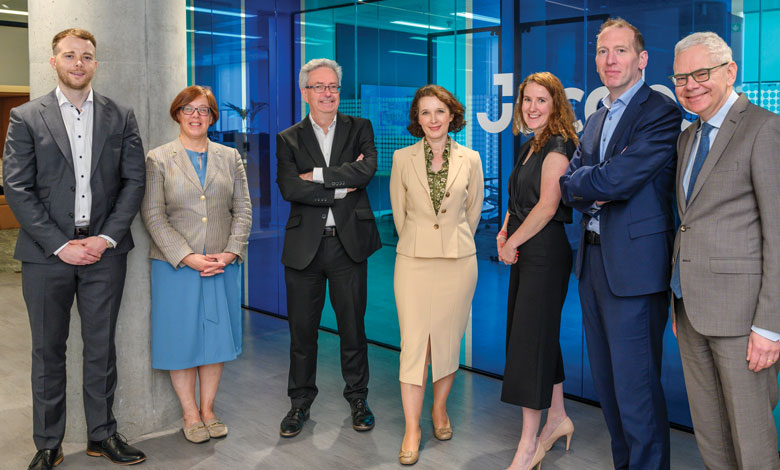
Jacobs hosted a round table discussion with key critical infrastructure providers from across several economic sectors to explore their perspectives on Ireland’s decade of infrastructure delivery against a backdrop of relatively high economic development, a tight labour market, and ambitious national climate objectives.
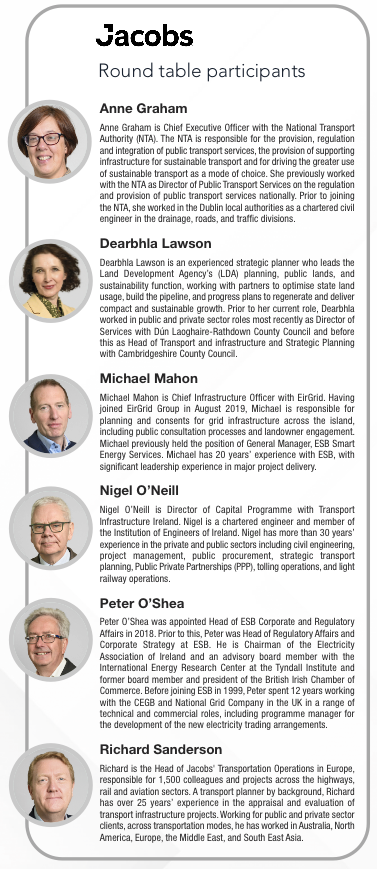
How can infrastructure delivery keep pace with Ireland’s ambitions for economic development?
Richard Sanderson
From Jacobs’ perspective, we understand the challenge through two lenses: the need to have the infrastructure in place to attract foreign direct investment in the first instance alongside the need to develop critical infrastructure to meet the demands of a growing economy. Infrastructure delivery requires three things: people, planning, and pipeline. Firstly, while the talent that we have in Ireland is extraordinary, we are at virtually full employment, so ensuring a strong talent pipeline and leveraging technology to support delivery is vital to us. Secondly, we must streamline the planning process, improve consenting, and deliver infrastructure as quickly as possible. Finally, regarding pipeline, a government commitment to an ambitious capital programme in the coming decades provides certainty for Jacobs and others to invest and provide adequate capacity alongside colleagues elsewhere in our industry.
Anne Graham
In terms of Ireland’s ambition, it is absolutely crucial that the development of infrastructure is linked to economic development and to ensure that we have a good quality of life for all. The delivery of high quality local, regional, and international connectivity will be key to ensuring that Ireland is an attractive investment proposition for both internal and external markets. Sustainable transport plays a key role across all tiers of the economy and driving lower costs in delivery is vital. Public transport initiatives are key to the sustainable delivery of infrastructure and wider development, including in housing and employment. We must also recognise that we have recently experienced a decade of non-delivery so we must sustain the pace of delivery, not just in this decade, but into the future to ensure our infrastructure catches up with our economy.
Dearbhla Lawson
In supporting our ambitions, the provision of sustainable and affordable housing is a critical social and economic infrastructure that is not just an enabler of growth, but necessary for continued cohesion and prosperity. Housing is fundamental in relation to Maslow’s Hierarchy of Needs and important to plan for this as a priority as necessary infrastructure. The LDA is well placed to support with addressing key challenges, through building up the pipeline, optimising state lands in the right locations and developing on private lands in the near term to deliver housing to meet the growing needs. Ireland is to continue to be an attractive destination for economic growth and future investment; the provision of affordable and social housing supply is critical to support our ambitions, wellbeing, and quality of life for all.
Following a period of unparalleled economic growth over several years now – one of the highest rates of economic growth in Europe – we need to be optimistic and ambitious about the future to ensure that infrastructure supports our future sustainable growth ambitions. From the Land Development Agency perspective, there is an opportunity now, through the review of the National Planning Framework to take a more holistic and coordinated approach to planning for infrastructure delivery to support the extent and pace of growth.
Michael Mahon
We cannot plan in isolation. From a housing perspective, an electricity connection is required and EirGrid and ESB are critical to that. Similarly, for transport, projects such as MetroLink and DART+ West have a huge requirement in terms of electricity. As such, stakeholders must work together and understand what is needed and when. We must align our delivery objectives. We have always looked at 2030 as being a key target year for delivery, but the time between now and the beginning of 2030 is less than 300 weeks. We must seek to understand what each other’s ambitions are now and then work backwards from there.
Nigel O’Neill
From a TII perspective, the consenting infrastructure is crucial. By that I mean the State’s exercise of its power in regulatory activity; providing planning permissions for capital projects. In recent years, that has been a bottleneck. Between 2000 and 2010, the project lifecycle for the major interurbans corridors – totalling around 750km of motorway – was around eight years. Today, the lifecycle of equivalent projects would be 15 years. It still takes the same amount of time to design, procure, and build, processes which are now the safest and least risky aspects of what we do. However, the planning stage is taking too much time. The NDP review is an opportunity to reevaluate where the State wants to be in 2030.
“Staff retention is just as important as recruitment, and demonstrating our purpose is very important to our workforce…” Dearbhla Lawson
Peter O’Shea
Economic development is fundamentally dependent on infrastructure; it is not simply about keeping pace. Planning and people are important, and alongside those I would add capital and incentives to ensure that we get the right people, engagement, and plans in place to deliver. In the energy sector, there has been huge delivery in the decade. From a virtual standing start in 2010 to 2020, 40 per cent of all electricity consumed in Ireland is now renewable and that requires grid systems and generation systems. It has been a huge challenge and a huge success. However, the wind does not blow every day and the sun does not shine every day, so we need more. ESB is planning on the basis that between now and 2040, electricity demand will double. The fundamental principle that we must change is that until now, the electricity system has been planned on a demand-following basis. We must move to demand-leading and get ahead of it.
In a challenging labour market, how is your organisation seeking to ensure adequate skills capacity for delivery?
Peter O’Shea
In the immediate term, ESB has recruited almost 1,000 people over the last 18 months against a base of between 8,000 and 9,000. Central to this recruitment has been establishing ESB as an organisation with a very clear purpose. People prefer to work for organisations that have a purpose. ESB’s purpose is totally aligned with responding to the challenge of climate change.
In the long term, we have an initiative called ESB Science Blast which is a non-competitive education programme for primary schools aimed at encouraging whole-class science investigations to pique the scientific curiosity among many children. It is hoped that some of these children will then embark on 10, 15, or 20-year journeys contributing to engineering competence in Ireland.
Michael Mahon
Partnership is key. The days of having all the expertise in a single organisation are gone. We must be open to bringing partners into an organisation and not distinguishing between those who are paid, for example, by EirGrid, and those who are paid by someone else. That has worked very well within the infrastructure team in EirGrid where we have increased our numbers from 80 to 240 in 18 months. Much of this increase has been delivered through partnership. The challenge now is retaining this new talent. This links in with Peter’s emphasis on purpose; the answer to why we do what we do.
Dearbhla Lawson
As a relatively new organisation, the Land Development Agency established in statute in 2021, has grown from a workforce of 10 to 150 over the last four years and is set to double in size again as we deliver on our mandate. In this regard, staff retention is just as important as recruitment, and demonstrating our purpose is very important to our workforce: delivering affordable homes and creating sustainable communities. That resonates very strongly with colleagues coming into the organisation, as does the strategy and LDA’s business plan which demonstrates our commitment and pipeline for delivery for the next four years of around 14,000 affordable and social homes. The breath of work that the agency does is also attractive, as is the collaboration and opportunities to innovate which is important for us. In terms of partnership working, we work closely with stakeholders, such as local authorities, state agencies, utilities and the development industry including ConstructInnovate whom we partner with, Ireland’s national construction technology centre, to explore opportunities to innovate and trial efficiencies through digitalisation and modern methods of construction.
“There must be enhanced cohesion between infrastructure delivery partners.” Michael Mahon
Anne Graham
A pipeline of projects is crucial to talent retention as well as the retention of good client partners. The NTA has operated a partnership model since its establishment during the economic crisis when it was limited in its direct employment scope. We have always sought strong partnerships – including consultants and designers – to assist us in developing our programme. Now, we are engaging with government and public sector bodies to identify opportunities for the development of skills. For instance, in April 2024, we launched our first graduate programme to recruit new talent that will grow with us. The NTA is fortunate in that its purpose and values resonate with many young people in terms of active travel and enhanced mobility. This means that we are an attractive employer.
Richard Sanderson
Graduate development and apprenticeships are crucial for Jacobs. Many of the skills we will require in the future are very different from traditional demand. Jacobs’ global footprint also offers access to expertise from around the world to work with our local teams. Elsewhere, including in the UK, we are now focusing on reskilling long-term staff who have spent a decade focused on, for example, highway construction. We are providing them with new purpose to ensure that we have the skills to meet future demand, for instance, in the delivery of water and energy infrastructure.
“The NDP review is an opportunity to reevaluate where the State wants to be in 2030.” Nigel O’Neill
Nigel O’Neill
TII has 293 people within its organisation. We oversee national roads, greenways, and Luas on behalf of the NTA. In our overall ecosystem, there are around 3,000 people. That figure fluctuates depending on the number of construction projects underway. However, there is a wider challenge. I am in contact with the heads of schools of engineering across the colleges and anecdotally, there are fewer people undertaking civil engineering courses. There has been a withdrawal on behalf of the State away from investment in large civil engineering projects. I am optimistic about the second half of the NDP, but the reality is that parents and young people have received a signal that the State has deprioritised investment in certain types of infrastructure. The message I have for senior civil servants is that there is a need for stability in policy-making; please do not assume that civil infrastructure is a cost that can be switched off and switched on again after five years; the skills must be continuously cultivated and nurtured.
What have the recently published Infrastructure Guidelines meant for the delivery of capital projects?
Anne Graham
The Infrastructure Guidelines have led to a more streamlined approach to government approval of major capital projects by introducing the mandatory €200 million threshold and reducing requirements for certain approval rates. Under the Public Spending Code, we experienced approval waiting times of up to 18 months for preliminary business cases. It is still too early to say whether the Infrastructure Guidelines will address that.
Michael Mahon
The Infrastructure Guidelines are complementary to what we are already doing as a regulated body. There are a lot of aspects which will enable streamlining, but the Infrastructure Guidelines will also introduce other elements, such as project assurance, which will be beneficial.
Dearbhla Lawson
We welcome the streamlined support access and approval gateways. The LDA has its own approval system which aligns with the principles of the Public Spending Code and as such the Infrastructure Guidelines. While the guidelines bring certainty regarding the approval gateways and criteria, it would be helpful to have clarity regarding the key infrastructure projects on the horizon needed to support major housing and economic growth projects for example. I would love to see outcomes-focused approach to infrastructure prioritisation projects, considering the wider socio-economic benefits for projects support Policy priorities such as affordable and social housing. We must rethink planning in respect of long-term sustainability, and low carbon development and not just in terms of the hard infrastructure but also nature-based options including the green and blue infrastructure projects.
Nigel O’Neill
The Infrastructure Guidelines raise the threshold from the Public Spending Code figure of €100 million to €200 million, which is welcome. However, even one of our big national infrastructure projects alone far exceeds these figures. Overall, it gives me the impression of more control being leveraged on something which is viewed as a cost, and not enough focus on benefits. What we need is professionalisation and cooperation between the public and private sectors if we are to push forward.
Peter O’Shea
We must focus on the realisation of benefits that infrastructure projects can bring because this is a major driver catalysing delivery in respect of shared outcomes.
“Jacobs’ global footprint also offers access to expertise from around the world to work with our local teams.” Richard Sanderson
Richard Sanderson
The Infrastructure Guidelines provide welcome detail on construction productivity as well as climate and environmental performance. The independent review mechanism may slow things down to an extent, but it is also an important feature and the way it has been formatted is excellent. However, it will be a missed opportunity if the Infrastructure Guidelines do not resolve planning delays.
What are the most significant trends emerging in infrastructure delivery?
Michael Mahon
There must be enhanced cohesion between infrastructure delivery partners. If we work in isolation, then progress in infrastructure delivery will grind to a halt. Communication is key to maintaining momentum; it is about every person involved in the project understanding the rationale behind a project as well as the benefits it unlocks for the State and its people. If you understand and communicate the ‘why’, then it is much easier to engage wider society on that journey.
Dearbhla Lawson
Taking a low-carbon development and sustainability approach is necessary to achieve our vision for the future. The Land Development Agency’s purpose is to maximise the support of affordable and social homes in a financially sustainable manner supporting community development and positive social impact. One way we do this is looking at how we can best optimise underutilised brownfield public land, where the State has already invested in infrastructure and services and there is potential to deliver affordable and low carbon housing and deliver wider benefits for the town or city centre. We published the first Report on Relevant Public Land in 2023 to identify public lands that could potentially be used for the development of more affordable and social housing not the future. This is a useful tool to explore potential optimal use of public land, recognising that this is a finite resource. The use of land may need to evolve in the future, particularly in our cities to support a low-carbon and climate resilient future. If we want to help create a truly sustainable future, then we need to holistically examine how people can be enabled to live more sustainability. We need to take a long-term approach where we establish a shared vision, and priorities. Collaboration is key to that.
Peter O’Shea
Climate action and sustainability are the anchors which determine everything that ESB Group does. Our simple vision for the future is focused on decarbonising the electricity system and then using green electricity to displace fossil fuels in heat and transport. While 40 per cent of all electricity consumed is now green, the challenges ahead are massive. By the end of this decade, we must ensure that 80 per cent of electricity consumed in Ireland is generated from renewable sources. To meet our net zero targets by 2050, we need our electricity system to be at net zero by 2040. To do that, we need a multisector plan, and we need to explain that vision to citizens.
Anne Graham
Sustainability is a key trend. Within this, we must give more consideration to embedded carbon. We must understand emissions in the context of the supply chain, particularly in relation to transport fleets. We must also have a much wider acknowledgement of the role of equality, diversity, and inclusion in our designs, whether that is with consideration in planning, or in building the workforce of the future necessary to meet our infrastructure delivery targets.
Richard Sanderson
I agree that sustainability and collaboration are key; this includes collaboration between organisations and across sectors. Another key trend is digitalisation, including artificial intelligence – although we are still in the early stages of its development. There is much we can do as an industry to ensure that we deliver many elements of our service – whether that is planning, documentation, or design – all with the purpose of enhancing efficiencies for our construction colleagues to deliver the infrastructure that Ireland requires. There is a broad need for digital overlay to improve efficiency in delivery and achieve more with the resources available to us.
Nigel O’Neill
Digitalisation enhances efficiencies across supply chains, broad delivery targets, contractual obligations, and early warning notices, as well as monitoring these different elements. Collaboration is another trend. Historically, we have worked in siloes; we should not ignore the importance of our corporate governance responsibilities, but collaboration is essential and must be driven from the top. As such, I would like to see the establishment of a cabinet subcommittee on infrastructure to lead this.
What is your organisation’s vision for the decade of delivery?
Dearbhla Lawson
For the Land Development Agency, we have a clear vision, defined by delivery which is the critical outcome for the next 10 years, maximising the affordable and social housing supply in a financially sustainable manner and supporting the creation of sustainable, affordable communities. This also means building a stable and secure pipeline into the future – whether on state land or via the acquisition of land in the near term – particularly in an area of high housing demand so that we can help to build in stability and ensure more affordability through the economic cycles.
“Public transport initiatives are key to the sustainable delivery of infrastructure.” Anne Graham
Peter O’Shea
ESB’s vision is to decarbonise the electricity system. We have committed ourselves to be net zero by 2040 in all operations across scope one, two, and three emissions. We are starting to make progress on that. At the same time, we want to ensure a system which is resilient. Electricity provides 20 per cent of our overall energy mix, but resilience will be key if we are to meet future projections of electricity accounting for up to 80 per cent.
Michael Mahon
In the long-term, we have a new roadmap document, Shaping Our Electricity Future, which looks beyond 2030. We are delivering for 2030 and will pose questions to government for 2040 and 2050 outlining how to get to our net zero targets. We are well underway in delivering the Celtic Interconnector with work underway in County Cork and in France which will allow us to sell 700MW of electricity to France when we have a surplus of electricity. We will have a surplus of offshore wind energy, the question is what we will do with is, whether that is hydrogen production, exporting it, storing it, or another end-use.
“Economic development is fundamentally dependent on infrastructure; it is not simply about keeping pace.” Peter O’Shea
Anne Graham
Our vision is to connect people and places with sustainable transport infrastructure. To do that, we need to collaborate across the public and private sectors, exploit opportunities to delivery infrastructure and deliver better value for money. We have undertaken consolidated market engagement. We know that we and many different sectors and companies, both inside and outside of Ireland, have a role to play and we need to enable this.
Nigel O’Neill
My vision is to get our projects in the planning pipeline with planning approved and shovel-ready. When the second half of the NDP hits, we aim to be ready to go. That is challenging but that is my vision. This, if delivered, will consist of Metrolink, more Luas (Finglas and Cork), greenways, the National Cycle Network, and the TEN-T network in Donegal where it is badly needed.
Richard Sanderson
We are very excited for the decade of delivery. Last year, Jacobs hosted a trade visit by officials from New Zealand in London looking at our delivery of mega projects. When a delegation came over this year, they wanted to see infrastructure delivery in countries of a similar size to New Zealand, so they travelled to Ireland. The New Zealand officials remarked positively on the collaboration between entire government departments in delivering infrastructure as per the National Planning Framework. Speaking as an observer, I can say that Ireland’s infrastructure delivery is on the right track and we at Jacobs are very excited to play a role in that.

